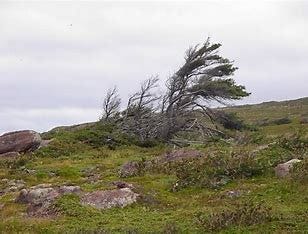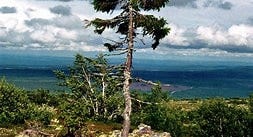What in the world is a Tuckamore?
Some years ago, Jim and I took a bus tour of Newfoundland with Earl Clint of Beamsville. It was a great trip. Earl is a teacher, and he had a binder for each of us. They included information, maps, and puzzles for long parts of the bus ride. It was a great trip, but do you know what I remember most? Seeing tuckamores.
Tuckamores are little balsam and spruce trees that grow along the northwestern shore of Newfoundland. They are small, perhaps one to two feet high, yet these little trees can be up to 200 years old! What makes them so small? They are pummelled by strong icy winds blowing off the Gulf of St. Lawrence and the Atlantic Ocean. This prevents them from growing normally, yet it does not prevent the trees from surviving in their harsh climate! They are an example of hardiness and resilience in nature.
Photo by Cheryl Klym-Edwards
This reminds me of another interesting tree, the Tjikko believed to be one of the oldest trees on earth. The Tjikko (named for the discoverers’ dog), is a 9500-year-old Norway spruce on Fulufjallot mountain in Sweden. It is the oldest living Norway spruce, and one of the oldest trees on the planet. It is a vegetative clonial tree which for many years was considered to be a twisted dwarf tree. A new trunk has recently grown on the tree so that it has reached its present size of 16 feet. The oldest part of the tree is below the ground in the root system. The tree was discovered in 2004 by scientists Leif Kullman and Lisa Oberg who consider that the new growth is due to global warming.
Photo by blogspot.com



